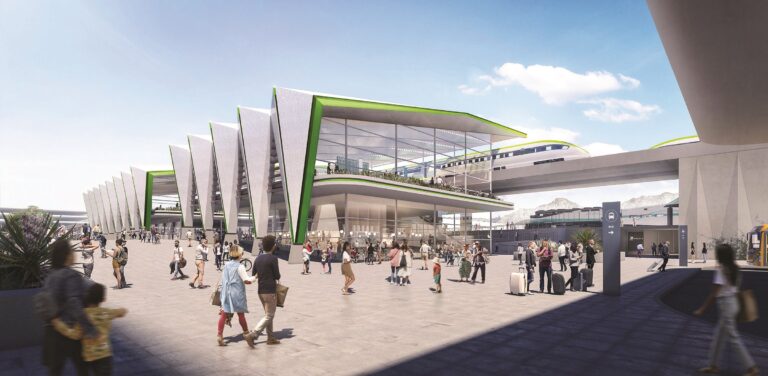
Brightline West, the affiliate of Miami-based Brightline Holdings that is planning to build a high-speed rail line from Las Vegas to Southern California, is close to solidifying the planned line’s connection to the Metrolink rail system, allowing passengers to travel by rail from Las Vegas to downtown Los Angeles’ Union Station.
Wes Edens, co-chief executive of New York-based Fortress Investment Group, which owns Brightline Holdings, told the Las Vegas Review-Journal last month that Brightline West has secured right of way for a 49-mile connector route between the Vegas line’s initial terminus in Victor Valley, through the Cajon Pass to a Metrolink rail station in Rancho Cucamonga in the Inland Empire. From there, passengers could connect through Metrolink to Union Station.
What’s more, that segment has now entered the environmental review process from the Federal Railroad Administration. According to the FRA’s website, the environmental review for the “Cajon Pass High Speed Rail Project” is scheduled to conclude by Nov. 30.
These developments now move the high-speed rail project much closer toward a single route connecting Las Vegas and Los Angeles — a long sought-after goal for high-speed rail proponents and developers dating back nearly 30 years.
The FRA’s website describes this rail segment as having two new rail stations — one in Hesperia and the other in Rancho Cucamonga adjoining the current Metrolink station. Brightline West had previously disclosed it had acquired the land in Rancho Cucamonga for the station there. The trip between Victor Valley and Rancho Cucamonga would take approximately 35 minutes, the website said.
Trains would run daily at 45-minute intervals between Victor Valley and Rancho Cucamonga, according to the FRA’s website. This frequency would make it much easier for passengers to connect to the Metrolink system without having to endure long waits.
The FRA’s project description also said the high-speed rail cars would be powered by an overhead electrical line; so much electrical juice would be required that the agency notes a new power substation would have to be built in Hesperia just to handle the trains going through the Cajon Pass.
One potential complication for Brightline: the high winds that frequently funnel through the Cajon Pass. Not only could those winds bring down segments of the electrical line and halt train service, but they could also spark wildfires.
Brightline estimated the cost for the entire rail line — including the 49-mile Cajon Pass connector — at $8 billion.
The company already has the authority from both the states of California and Nevada to issue up to $3.2 billion in tax-exempt bonds for the project. Brightline attempted to go to market with these bonds back in late 2020, but lack of demand due to the pandemic forced the company to pull the offering.
Edens told the Las Vegas Review-Journal that the bond financing package is still being considered, though he declined to give a timetable.
Meanwhile, Brightline is also hoping to tap into funds in last year’s $1.2 trillion federal infrastructure financing bill that are set aside for high-speed rail projects.
Most of those funds would be awarded through competitive bidding; again, Edens declined to say how much Brightline would seek from this pool of funds.
That infrastructure bill also gave a potential boost to a rival rail project connecting Las Vegas to Los Angeles — this one from the Washington, D.C.-based National Railroad Passenger Corp., more commonly known as Amtrak. The rail service has on its website a plan to restore the Las Vegas-to-Los Angeles route that it suspended in 1997 due to lower-than-expected ridership. But there is no timetable given for when that service might be restored.
